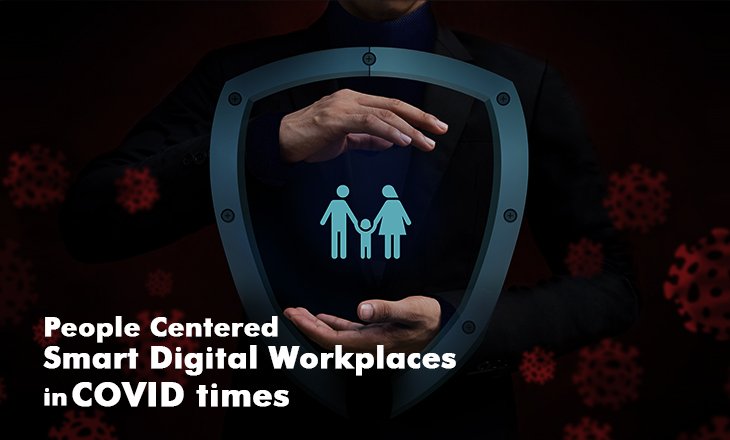
People-Centered & Smart Digital Workplaces In COVID Times
The world itself is going through a tough time due to the impact of the pandemic. It has shaken the whole human race. During this unprecedented time, companies have done a solid job of addressing their employees in the right way. Special notions are being taken concerning the needs of safety, stability, and security of their employees during the pandemic. However, every action taken by the organization should keep people at the center, for they are the core factor behind the success of every organization. Therefore, changes and adaptations of smart digital workplaces should be people-centric.
Smart Technology To Lead The Future Office Scenario:
As the pandemic infiltrates every corner of our lives, there is one place that is perhaps more affected than any other. The office buildings- whose very existence has turned out to be a big question. A return to the workplace should meet new rules on hygiene and social distancing.
There arise many questions revolving around this.
It is not when we will return to our offices, but it is about how we will return to our office during this time of ‘new normal.’ Will the post-pandemic workplaces start to resemble our old offices of the 1980s, having cubicles and compartmentalization?
Will the reception areas be changed from magazines and corporate videos to sanitizers, temperature checks, etc.?
However, we can be sure that smart technology can play a very significant role in the future office.
Cloud-Based Smart Digital Workspaces Solution:
Cloud-based platforms are gaining traction at a much faster rate, as teams from anywhere can easily get access. There lie many advantages of moving data, business apps, and services to a cloud-based platform.
- Accessibility across geographies:
A cloud-delivered WaaS desktop provides flexibility for teams by deploying all functionalities in a remote environment also. Devices such as laptops, tablets, smartphones, and PCs also can deploy this facility to allow their teams to access the services flawlessly.
- No dependency on internal IT:
WaaS allows independence from the internal IT services of the organization. The services and applications required by teams are delivered via a virtual environment, and one-time installation will enable teams not to be dependent on IT personals to do the individual setup.
- Better security:
Cloud-based platforms and other virtual environments are secure and smart digital workplaces because data backup is always available. It helps to recover data whenever required. Daily, weekly or monthly basis we can perform these backups.
WaaS vs DaaS:
WaaS is a more advanced form of the DaaS model. It provides the basics of a desktop workspace. The Desktop-as-a-Service model is a skeletal framework that provides a virtual work environment for the users with OS and other application installation step-by-step.
Workspace-as-a-Service deployment accompanies Operating system, anti-virus protection, data backup, data storage, applications, etc.; it acts as a ‘single-shot deployment. It consists of an entire package of software and apps, and it does not require custom installations for each application unless there is any additional requirement.
Three Key Focus Areas For Successful Smart Digital Workplaces-
- Working smarter:
In this remote working time, collaboration and communication tools are ruling the hour. This helps to create a positive impact on your teams. Smart workspaces require smart collaboration and communication tools for video conferencing, whiteboarding, document sharing, etc. These tools enhance communications and help teams to stay in the loop.
- Prioritizing simplicity and integration:
Productive workspaces should help individuals to use tools easily. This requires seamless integration; see to it that the tools that your teams come across daily can be integrated along with other collaboration tools. This provides them a single-app-like experience.
- Keep security prior:
Potential security gaps exist on employee devices when the workspace is moved remotely. Enterprise-grade security allows businesses to identify security threats and keep team meetings and documents safe. Companies should take steps to implement end-user awareness training, two-factor authentication, etc., for remote teams.
Smart Infrastructure Holds The Key:
Tech systems and services have scored during this pandemic, as those organizations which were unwilling to embrace remote working were forced to give it a go. The organizations that have transformed to connected IoT buildings during the pre-pandemic will obviously have an advantage when returning to the office. Smart infrastructure can provide data and insight about how people and design can work together in the ‘new’ office environment.
Digital building infrastructure enhances remote services while collecting information related to entire building portfolios. This can be very beneficial to understand the occupancy of a particular building or a series of buildings. Real-time data will help to know peak office times and also identify the higher-risk area within the building.
Utilization Data To The Fore:
Recently, there is much-animated design discussion about post-pandemic office workspaces with cubicles, carpets, plexiglass screens, etc. that does not make you closer to the next person’s desk. Incorporating smart infrastructure will let managers updated with the utilization data such as the maximum occupancy in an area, social distancing practices, etc. Occupancy data will show the data relating to how many people are in an area and generate alerts if too many people are crowded up. Thus, the hotspots can be easily detected and can do the needful, a precaution to secure people.
These methods are also energy-efficient and have a less environmental impact. Because we should not forget the fact that behind the coronavirus shadow, there lies the shadow of the climate crisis. This pandemic has brought to light that people’s comfort and safety are prior to any organization, and advanced standards should be taken to build this.
Conclusion:
It is to be noted that there lays no compromise in the employees’ comfort, health, and well-being. Organizations have to work smarter, and buildings must become smarter too. Advanced smart technology has helped organizations in all means to cope up well with pandemic times. You can get Leader Group services





